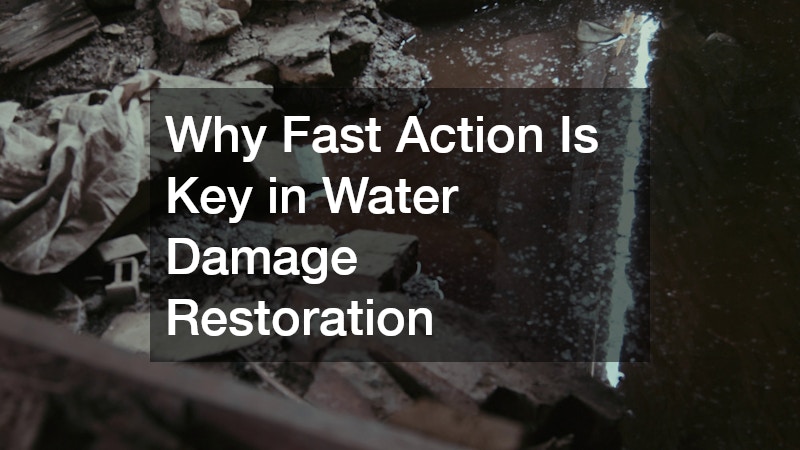Water damage is a pressing concern that necessitates immediate attention to avert potentially devastating consequences. Without swift action, the latent risks associated with water damage can compound, leading to severe structural complications and increased restoration costs.
This article delves into the critical importance of rapid responses in water damage restoration. By understanding the potential risks and embracing prompt action, homeowners and property managers can effectively mitigate long-term damage and preserve their assets.
Overall, swift intervention is not just a matter of urgency; it is a practical approach to safeguarding property, health, and finances. Delays in addressing water damage exacerbate challenges, making it vital to act immediately when such situations arise.
What Are the Immediate Risks of Delaying Water Damage Restoration?
Structural Damage
Delaying water damage restoration can precipitate significant structural issues, weakening foundations and compromising the integrity of walls and ceilings. As water seeps into the structural elements of a building, it can lead to severe deterioration over time.
Even seemingly minor water intrusion can inflict substantial harm if neglected, initiating a cycle of decay that escalates repair needs. Over time, exposure to moisture can result in a loss of structural stability, posing safety hazards and necessitating costly interventions.
The longer water sits unchecked, the greater the potential for hidden damage that complicates restoration efforts and inflates costs. It’s essential to recognize the urgency of addressing water damage to prevent such far-reaching structural impacts.
Mold Growth
One of the immediate consequences of delayed water damage restoration is rapid mold growth, which can occur within 24 to 48 hours of water exposure. Mold spores thrive in damp environments, leading to health risks and increasing restoration expenses.
Unchecked mold growth can exacerbate respiratory issues and allergies, posing significant health concerns, particularly for sensitive individuals. Moreover, the longer mold persists, the more complex and costly its removal becomes, as it infiltrates various building materials.
To mitigate these risks, prompt intervention is crucial in curbing mold growth and maintaining a healthy indoor environment. By swiftly managing water damage, the potential health implications associated with mold exposure can be effectively minimized.
How Does Fast Action Minimize Restoration Costs?
Preventive Measures
Swift action in water damage situations serves as a preventive measure that curtails further deterioration and associated costs. By addressing the root cause of water intrusion and initiating repairs promptly, extensive damage can be avoided.
Prompt restoration prevents the escalation of issues, reducing the need for more invasive and expensive repairs. Proactively managing water damage means spending less on labor, materials, and overall restoration time.
The emphasis on immediate response is not only financially prudent but also crucial in extending the lifespan of the property and its components. By adopting preventive measures, property owners can significantly reduce restoration costs.
Insurance Benefits
Acting swiftly in response to water damage can positively influence the outcomes of insurance claims and coverage. Insurance providers often recognize the value of timely intervention in mitigating damage and may offer better compensation for prompt action.
By documenting damage and demonstrating swift remedial efforts, policyholders can enhance their chances of receiving complete insurance benefits. This proactive approach can limit out-of-pocket expenses for property owners.
Ultimately, understanding and maximizing insurance benefits is a key component of swift water damage restoration, highlighting the interconnectedness of timely action and financial security. Fast responses contribute to a more favorable insurance assessment.
What Steps Should Be Taken Immediately After Water Damage Occurs?
Initial Assessment
The initial assessment following water damage is paramount in determining the scope of necessary restoration actions. Identifying areas of extensive water exposure allows for targeted and efficient mitigation measures.
In this critical phase, effective communication and documentation play vital roles in guiding subsequent restoration efforts. A precise assessment ensures resources are allocated appropriately, ultimately streamlining the restoration process.
Combining a thorough assessment with immediate action facilitates a comprehensive strategy to address water damage. It enables property owners to take informed steps in restoring affected areas efficiently.
Professional Intervention
Engaging professional water damage restoration services is essential in providing comprehensive repair solutions. Professionals bring expertise, specialized equipment, and industry knowledge to ensure effective water extraction and drying processes.
Professional intervention minimizes the risk of secondary damage, safeguarding property and health through precise and efficient restoration techniques. Their experience is invaluable in navigating the complexities of water damage scenarios.
By entrusting restoration tasks to professionals, property owners can focus on recovery with the assurance of timely and high-quality outcomes. The expertise of restoration services facilitates a smoother, faster recovery process.
In summary, fast action in the face of water damage is indispensable for preserving property integrity, preventing health risks, and containing costs. Delays exacerbate challenges, creating a cascade of issues that complicate and extend restoration efforts.
This article has outlined the immediate risks associated with water damage, the benefits of swift intervention, and the crucial steps to be taken in mitigating damage expediently. By prioritizing immediate responses, significant complications and expenses can be avoided.
Ultimately, swift action is not only prudent but also a proactive measure that empowers property owners to navigate water damage with confidence and resilience. Acting swiftly safeguards not just physical structures, but also personal and financial well-being.




